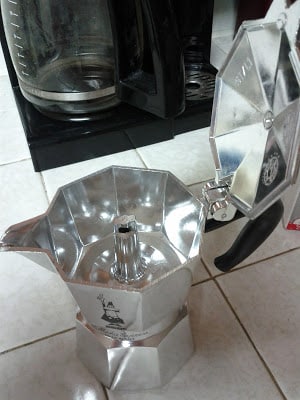 I have officially owned the Bialetti Moka Express 3-Cup stove-top espresso maker
I have officially owned the Bialetti Moka Express 3-Cup stove-top espresso maker for a month since middle of 2013.
I bought it in my local Fred Meyer on the 25th of June of that year and in the first month I used it around 30 times. This is obviously not as much as some people but for 30 efforts I feel like I’ve got it down – minus a bit of inevitable tweaking that I’ll refine over the next year or so.
In any event, if you’ve been following along here on the site you’ll know I recently gave away a 2nd Moka Express pot based on my first impressions of this awesome little contraption.
I also posted a few weeks back some basic cleaning instructions for the Moka Express.
Today I wanted to post a comprehensive review of the Moka Express 6799 – the three cup model – based on my use of this coffee/espresso maker over the first month I owned it.
First Things First
For all those coffee snobs out there you are correct – this moka pot (and all other moka pots) do not actually make espresso. Although the Moka Express can generate around 2 bars of atmospheric pressure while brewing this pales in comparison to a commercial espresso machines 9+ bars of pressure.
Yes, the moka pot generates enough to produce a tiny bit of crema in the pot it is rare to be able to transfer much of that crema (if any) to your cup without going through extra steps.
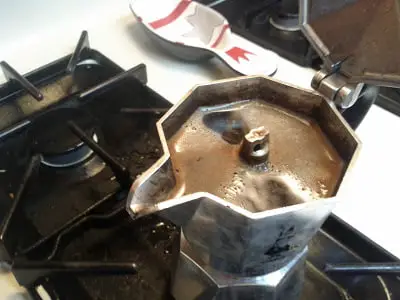
Having said all that though, with the exception of some extremely sensitive palates, almost no normal person is really going to be able to tell the difference between the Moka produced by this pot and the espresso produced by your local Starbucks.
So long as you use decent beans that have been “relatively” freshly ground either at home or the store and you follow standard Moka Express brewing techniques (outlined below) you’ll get an amazing drink every time.
You’ve Seen The Moka Express But Here, Look Real Close
Before I bought the Moka Express I was somewhat confused to it’s parts and how it works. I took some pictures of mine up close to explain what you’re getting yourself into and how the parts work.
First you have the base. It’s where your fresh water goes. It has a valve that releases pressure if it gets too high. So far I’ve not generated enough pressure in my pot for this valve to come into play. I have read elsewhere that because the valve shouldn’t release very often you should periodically wiggle it around a bit to make sure it doesn’t stick – you know, should the valve ever need to open.
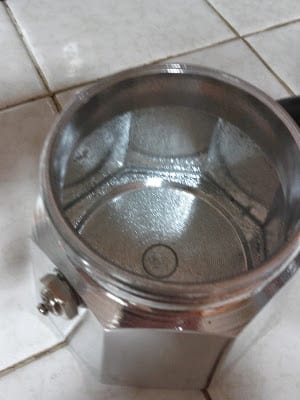
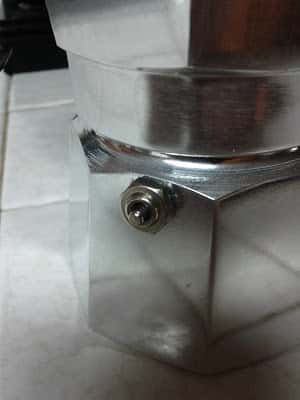
The middle portion of the moka pot is a small filter basket sitting on top of a funnel. As water heats in the lower chamber steam builds and pushes near boiling water up through the funnel into the grind sitting in the basket.
I’ve pictured below the basket empty when it was brand new and full after a month of use. Note that when full the grind goes to the top rim of the basket and is flattened out. It’s worth mentioning that you will always fill this basket to the top. It’s not really designed to work with less grind. Also worth noting – never pack the grind down like they do at a big espresso machine. This will make the pressure to high and can be a safety hazard.
Flattening the grind will pack it slightly so try not to pack it down anymore than you have to.
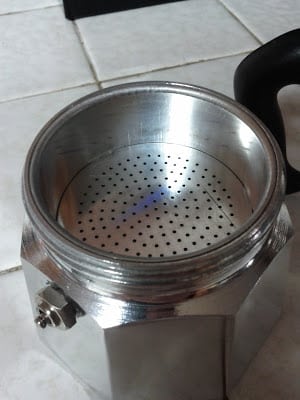
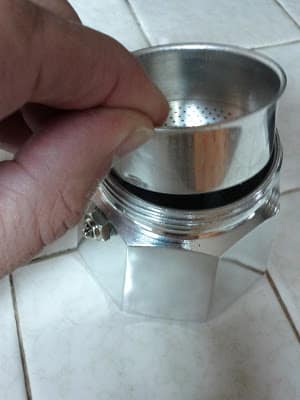
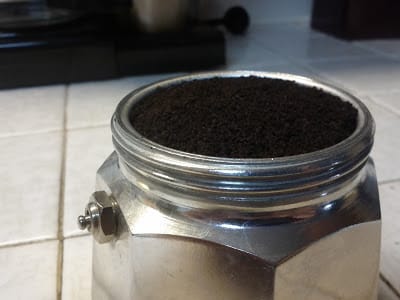
The top part of the Moka Express is an interesting piece and it’s the part that most confused me prior to buying the coffee maker. It also has a filter screen. The filter screen is located on the bottom of it and is encircled by a rubber gasket. See photo below. The new unit is pictured on the left and after 30 uses it looks like the one on the right – the gasket is a bit dingier.
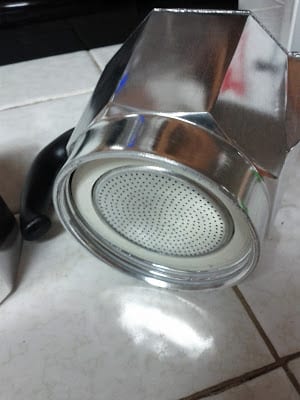
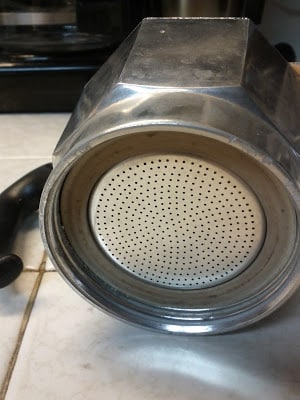
What happens during the brewing process next is that the hot pressurized water is forced up through the grind and then the “espresso” is then strained through the upper filter and through a second funnel into the top chamber. The rubber gasket provides the airtight seal needed to maintain all this pressure.
One (of a few) reasons why everyone says to brew a Moka pot on a low setting is to preserve the integrity and longevity of the rubber gasket. They are cheap to replace but you don’t want to do it if you don’t have to. Plus brewing on a low setting typically results in a better flavor as the flavor extraction period (where the pressurized water is in the grounds) lasts a bit longer.
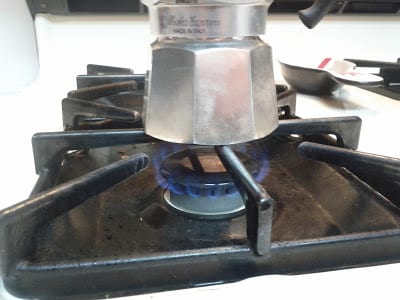
See pics of the upper funnel and the upper chamber below. Obviously the funnel is brand new in the 1st pic and well seasoned (merely rinsed with cold water after each use) in the second pic.
Also note the replaceable gasket – it is what holds the upper filter in place. I find it’s easier to remove these pieces by running them under water while you remove them. I don’t tend to heavily clean the upper chamber but I do clean the gasket and filter to ensure the seal is as perfect as possible.
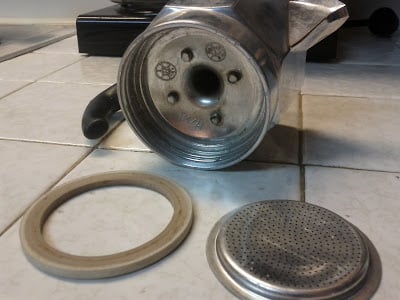
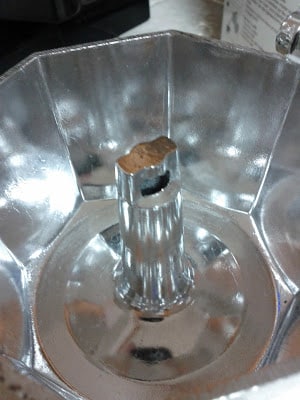
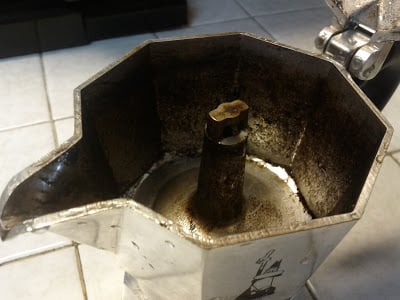
I didn’t quite get it at first but the lid on the top of the unit makes no difference at all in the brewing process. In the end when coffee spills out of the upper chamber the lid can prevent splashes so I tend to keep it closed but you can impress yourself and friends by keeping it open – just watch out for scalding hot liquid flying through the air at the very end. 🙂
Any Complaints?
Sure, there’s always complaints but usually they are nit-picky and they are in this case as well.
You can’t immediately clean the Moka pot because it’s too hot to the touch. You can mitigate this by running it under cold water. I’ve done this but I tend to just clean it later in the day after it cools down on it’s own. Takes about 15 min without intervention if you are wondering.
There is consistently a bit of “mud” on the bottom of my cup which I never get from a professional espresso machine. This problem can be minimized by using a better grinder – preferably a burr grinder for size consistency and a slightly coarser grind to minimize small particles that can “float” through the filter and into the final coffee product.
As I’ve tested this pot over the past month I’ve used basic medium grind that you’d use in a drip-coffee maker down to a fine grind that you’d use for a true espresso machine. So far my best experiences have been using something in between the two.
At the store just ask for something between espresso and drip grind size and if you’re doing it yourself change your coarseness accordingly. Remember, burr grinders crush beans to a uniform size and minimize the dust that blade grinders produce so much of. Your grinder makes a big difference.
Another point of annoyance is pulling the coffee grind basket out of the lower chamber. It’s hard to do if you don’t want to make a mess. I like to pull the basket and dump the grind in the trash or compost heap rather than wash it down the garbage disposal and it takes a bit of effort to do this cleanly.
Tastes Aside, What Do I Like About The Moka Express
In short the coffee produced is as good as any coffee I could ever imagine creating in the home and it costs hardly anything to buy one of these pots. The price is fantastic.
I also like that making this coffee is just as easy as running a drip coffee maker. The cleanup takes an extra 30 seconds or so but the setup is arguably simpler. Add water, place grind in basket, set Moka Pot on the stove on low. 5 min later I have 6 ounces of “espresso” which I can drink straight up or water down for a larger volume Americano. The drip coffee pot takes just as long and sometimes longer considering the warm up period before the brewing process ever even begins.
I also like that using this stove top coffee pot gives me the incentive to use fresh beans rather than pre-ground coffee. You can taste the difference so much better because the flavor extraction of the grind is so much better. If I buy a Kona blend and then compare it to a Kenyan the flavor differences are insanely obvious. This makes drinking good coffee a lot more like drinking fine wine. You get to really experiment with flavors – even people with poor palates will be able to tell the differences.
A Few Parting Thoughts
When I started using the Bialetti to make my coffee/espresso I wasn’t sure how much water to put in the bottom chamber. Following the advice of others and experimenting a bit I’ve found that it’s best to always use the same amount of water and to fill the chamber up to the bottom of the pressure release valve as pictured below.
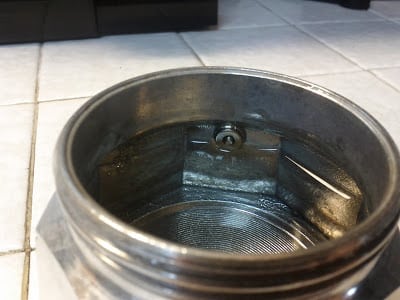
By filling the water in the lower chamber any higher than this the pressure starts getting too high and the brew time seems to increase a lot.
My guess is overfilling the chamber may be a safety hazard too. Filling it lower will result in poor pressure and a less than ideal brew. Without adequate pressure more water will be left in the bottom chamber and you won’t get as much espresso.
I’ve already noted grind size but as for the type of coffee roast this is all up to you and your own personal tastes. I’ve tried everything in mine from light roasts to dark roasts including espresso roasts which are about as dark as anything I’ve ever seen. It’s all about the taste you like.
My #1 recommendation is to buy a very small amount of beans at your grocery store every time you go and always get something different. Use them all until you start finding the right beans and roasts for your personal taste.
Have fun with it – I know I have.
If you don’t have a Bialetti Moka Express I hope this review was helpful. You can see the Moka Express 3-cup Moka Pot on Aamazon here. I bought mine for less in stores nearby my home but your mileage may vary in terms of pricing. In any event even at full price this is still one of the cheapest coffee makers you can get anywhere and it’s going to probably be your favorite too.
If you have any questions about anything – product dimensions, taste, design, whatever just drop them in the comments below. I’ll answer them all.
There’s a lot more to learn about moka pots. Check out one of the following articles on brewing stovetop moka or espresso right now!
► How To Use A Moka Pot To Brew Coffee
► The Best Stovetop Espresso Makers
► Stainless Steel Moka Pots
► How Long Does It Take To Brew Moka
► How Moka Pots Work
► Stainless Steel vs Aluminum Moka Pots
► 1-Cup Stovetop Espresso Makers
► 2-Cup Stovetop Espresso Makers
Bialetti Moka Express Stovetop Espresso Maker (Full Review)
 Everyone knows the Bialetti Moka Express is the best selling moka pot of them all by a landslide!
Everyone knows the Bialetti Moka Express is the best selling moka pot of them all by a landslide!
But why? Is it really that much better?
The Bialetti Moka Express makes coffee the same way as all the other stovetops you can buy. It comes with simple instructions and to get started you don’t need any filters, just your Moka Express and some coffee.
This stovetop espresso maker even looks just like all the others. In fact you have to try kind of hard just to find a moka pot that looks different.
Let me tell you right off the bat though, this moka pot may cost a fraction more than the cheaper options you can find for sale here and there but it is made so much better and it’s replacement parts are so much easier to find that it is a no-brainer to buy over the competition.
You can see quick pricing for the 6-cup Moka Express here or continue reading to learn a bit more about this really versatile coffee/espresso maker.
GGC’s Review of the Bialetti Moka Express Moka Pot
Let’s say you own one of these already but haven’t used it yet.
Before you start using your moka pot for the first time (and this pertains to all aluminum moka pots) you’re going to have to season the pot first. To do this you’ll make 2-3 pots of throw away coffee. 🙁
There are a lot of people who use an aluminum moka pot for the first time and their first pot tastes bad so they give up, but there is a lot of improvement to be seen with repeated use of the espresso maker.
So, while it hurts us all to waste the coffee it’s paving the way for a great coffee experience in the future. Maybe this could be time to use up any pre-grounds coffee you may have lying around a cabinet somewhere.
If you do season your pot just make sure to not wash your pot out after seasoning. You may rinse it but using any soap or abrasive scrubbers negates the whole process. You see, it’s the coffee oils that seal the aluminum surface making future runs taste a lot better.
Don’t like aluminum or this process? See our favorite stainless steel moka pots here.
How to use Bialetti Moka Express
 The Moka Express instructions are really pretty simple to follow:
The Moka Express instructions are really pretty simple to follow:
- First fill the lower chamber with cold water, the water level needs to come up to just below the valve.
- Next, place the funnel in position and fill it with ground espresso. Any coffee grounds left on the rim of the funnel will need to be removed.
- Screw the upper part of the pot to the base, make sure it’s on tightly to prevent leaks.
- You next need to light your stove and place your moka pot on the heat, if you’re using a gas stove please making sure that the burner is small enough that the flame does not reach to the sides of the pot, this is dangerous and can damage your Moka Express. Low to medium heat it enough to do the job.
- The pot needs to be left on the stovetop until the water boils, which will then cause the coffee to rise through the post in the center.
- When the top of the pot is full of coffee and you see a hazel colored foam, it’s almost done making coffee so you can then remove it from the heat.
Before pouring the coffee, stir it well to make sure that the flavors are evened out through every serving.
Finally, pour it into your favorite coffee cup and enjoy your espresso-style coffee. Read this if you didn’t realize stovetop espresso is different than traditional espresso.
How To Clean Bialetti Moka Express
The Bialetti Moka Express doesn’t need a lot by way of cleaning, the pot works best when coated a little with coffee oil – the aluminium is sensitive to cleaning products and any abrasive materials, such as wire wool. According to the instructions the best way to clean your Moka Express is to dissemble and then hand wash it with warm water without any soap or detergent. It’s not dishwasher safe.
Because many people think this is unsanitary stainless steel moka pots have started becoming a little more popular. See this post to learn more about why aluminum moka pots are safe too!
Before reassembly, make sure to thoroughly dry the parts as any trapped moisture could cause the Moka Express to rust and this will impact the coffee in terms of flavor and in terms of your health.
How Does The Bialetti Moka Express Work?
All stovetop espresso makers work in essentially the same way, the water heats up on the stove and the steam pressure generated by the boiling water forces the water upwards and then through the filter and the coffee grounds.
It’s kettle and coffee maker in one and it doesn’t require electricity, just a heat source, so it’s a very versatile piece of equipment.
With drip or pour over coffee makers water slowly falls through the grind making coffee on the bottom side. With stovetop espresso makers the pot generates roughly 1.5 bars of pressure as it passes through the grind going up to the upper collection chamber.
This method is ingenious and is a simple alternative to true espresso. The final coffee is even dosed in the same portion size as espresso – the only glaring difference is that you can’t get any significant amount of crema from a moka pot, even if you tamp down on the grind so don’t do it!
Tamping down makes it harder for water to pass through the grind and slows down the brew. Because pressure isn’t high enough this causes much longer brewing cycle to occur and over-extracted, bitter coffee can be your reward.
What Grind Works Best With Bialetti Moka Express?
The grind is important for the Bialetti Moka Express as it is with all coffee makers.
The Moka Express requires a medium-fine grind, but make sure its not so fine as to get through or clog the filter. When loading the coffee funnel, take care not to tamp the grounds, as this will prevent the water from getting through to brew the coffee, leaving you with a slow and over-extracted brew.
If you prefer however to use the same grind size as you would use for a drip coffee maker or other kind of pour over a moka pot will still give you acceptable flavors. Medium grind will come out just fine from a stovetop espresso maker but most people agree that a finer grind just tastes better in the end.
What Is The Best Coffee To Use In A Bialetti Moka Express?
As far as beans go, the moka is generally considered pretty versatile, and you can experiment and see what works for you. You can use espresso roasts even though you’re not making true espresso, provided the grind is right. If you’re buying pre-ground beans, espresso ones will be too fine for the filter on the Moka Express.
While you can use whatever suits you, it is most common to use mostly medium to dark roasts, as these lend well to the strong and full-bodied cup you’ll get from this brewing method.
Why Is The Moka Express Made From Aluminium?
Aluminium is used for stovetop coffee makers because it’s a great conductor of heat. There are often cries that you can taste the aluminium in the cup with all metallic coffee makers where others swear they cannot. Whether some people have more sensitive taste buds to other or whether this is psychosomatic, who knows?
The stainless steel alternatives are often considered to have less of an impact on the flavor of your cup, but this isn’t a view shared by all. In one admittedly unscientific experiment one man failed to find a difference, and it’s hard to find evidence that food-grade aluminium really does affect the flavor of your coffee any more than stainless steel ones.
Is It Safe To Use The Moka Express?
As with all products that are used on the stove, you need to take care when using a Moka Express. They can be dangerous of left to boil dry.
There have also been rumors of aluminium coffee pots being a factor in the cause of Alzheimer’s disease, but there is no evidence of this and people don’t share these concerns in relation to other aluminium based products, such as aluminium foil or soda cans. If you have concerns there are plenty of stainless steel coffee makers available, so if you don’t trust aluminium, a stainless alternative is probably your best bet.
How Is The Moka Express Different From Cheaper Moka Pots
There isn’t a lot of difference between the Moka Express and other, cheaper, moka pots. What you get with Bialetti is a brand that knows what its doing and a name that people trust. The design is also attractive and the Moka Express, like with other Bialetti products, is a good quality, well-made coffee maker.
It is slightly more expensive, but it can be better to pay a little more for a maker you can trust, and any replacement parts you need will be widely available, due to the popularity of the brand. Another perk is the two year warranty Bialetti offer on the Moka Express, so you know you can count on it lasting or being replaced, good news.
That said, there are many good quality alternatives that won’t set you back as much, so if you’re happy to shop around and do a little research (and you must be, you’re reading this!) then you could save yourself some money without a significant compromise in quality.
Biggest Problems With The Moka Express
The Moka Express works well, it looks good and it is tough and sturdy enough to last. Bialetti certainly do a good job of making coffee-makers. However, there are a couple of things they could have done differently.
Firstly they could have used stainless steel, while there isn’t a lot of evidence as to the toxicity of aluminium over stainless steel, the perception that it’s dangerous will put a lot of people off. Stainless steel is also easier to clean, as you can use coffee maker cleaning products with it, aluminium is to vulnerable to corrosion for that.
Secondly the price is a little steep when compared to alternatives, although at Gathering Grounds we appreciate the advantages of using a big brand that we trust and have used before, for a newcomer to coffee making, the price might well be prohibitive. The beauty of coffee-makers is in the simplicity and while the design is great on the Moka Express, the fanciness of it can be said to take away from its basic charm.
Who Is The Moka Express Best For?
The Moka Express is best for anyone who wants to just but a coffee maker without too much mulling it over. If you just want something of good-quality that works then Bialetti are the brand and the Moka Express is a very decent model if you’re sure you’re looking for a stovetop.
Of course you’ll need to appreciate the rich and full-bodied coffee it produces, which isn’t everybody’s favorite, but at Gathering Grounds we recommend these stovetops as a great and more practical alternative to the expensive and high tech espresso machines you can buy. If you appreciate the art of coffee making and enjoy espresso, then this might be the solution for you.
The Moka Express is small and portable too, so if you like to carry around coffee equipment to work or travelling, then you can. You need to bear in mind that with all stovetops you need access to a stove, so while you may not be able to take it to work and use it there, they are a great addition to any camping trip. If you travel a lot and find yourself drinking bad coffee while you’re there, the stovetop regulates itself by brewing at the same temperature so you won’t need to be measuring your water temperature like you need to for other methods.
What are the Alternatives to the Moka Pot?
There are a few good alternatives to the Moka Express. You can buy a cheaper unit from a lesser known brand. Go for an Aeropress, an inexpensive steam espresso maker, or even a Handpresso!
